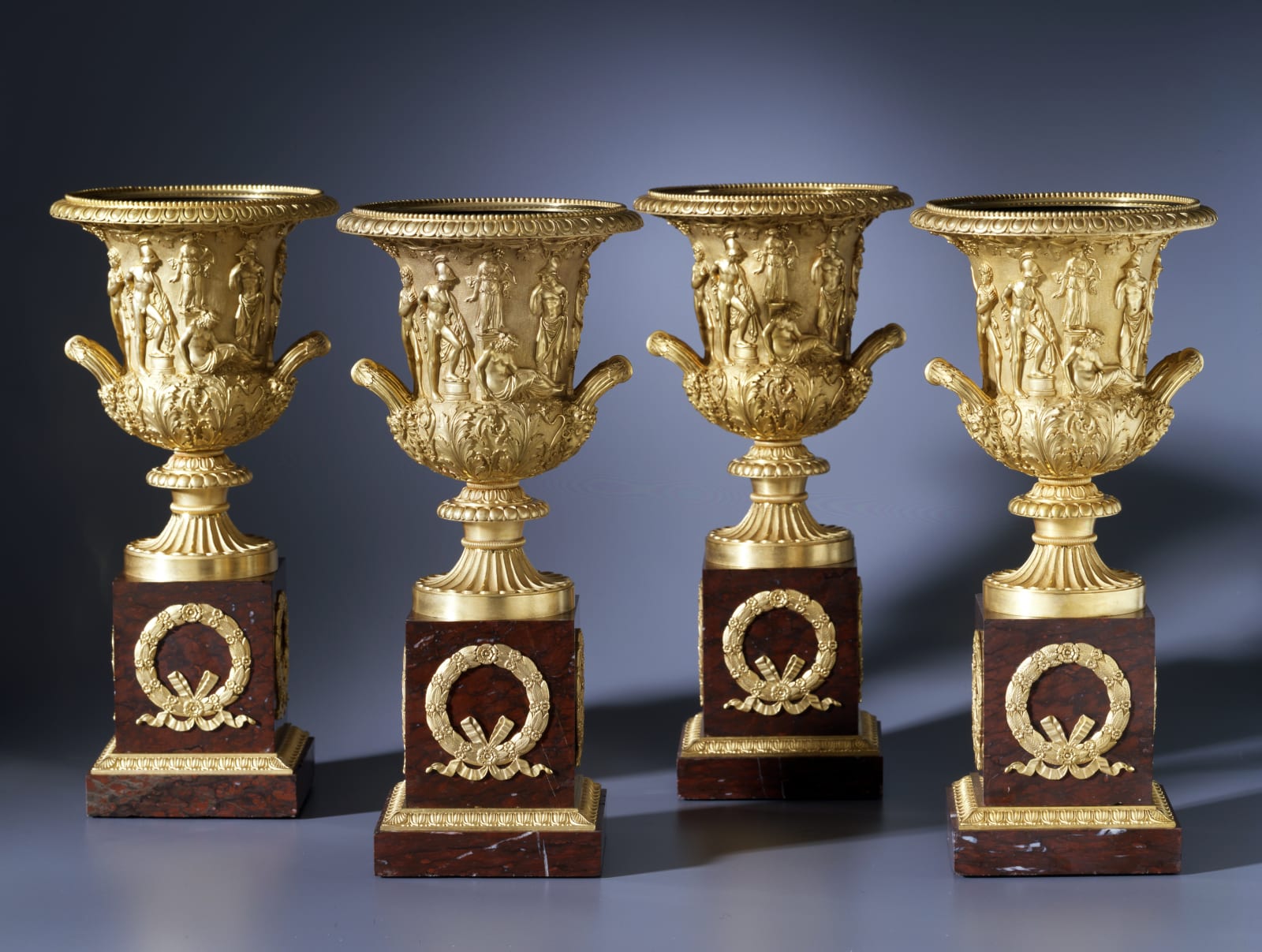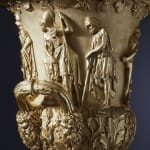Pierre-Philippe Thomire (attributed to) French, 1731-1843
An exceedingly fine set of four Empire gilt bronze and rouge griotte Medici Vases on pedestals attributed to Pierre-Philippe Thomire each of krater form with a beaded and gadrooned rim above a frieze of vines and centred by figures of Achilles, Ulysses and Agamemnon beside Iphigenia crouched below a statue of Diana, with fluted handles issuing from bearded masks, on a spreading fluted circular foot and square griotte pedestal decorated with ribbon-tied wreaths on a stepped base with lotus-leaf cast border
Paris, date circa 1810
Height 49.5 cm, diameter 23 cm. each.
Given their quality and subject matter this very fine set of vases can be attributed to the eminent fondeur-ciseleur Pierre-Philippe Thomire (1751-1843), who was well aware of the beauty of the Medici Vase. The original vase dates to the second half of the 1st century A.D. and with the Borghese Vase, is ascribed to Phidias. By the sixteenth century the Medici Vase was in the Villa Medici, Rome. It was removed to Florence in 1780 and soon after displayed in the Uffizi, where it remains today. From the seventeenth until the nineteenth century both the Medici and Borghese were the most admired antique marble vases. The two were often compared and copies of them arranged as companions. During the second half of the seventeenth century many prints of the Medici Vase appeared. Three copies along with replicas of the Borghese Vase were made for the Bassin de Latone in the gardens of Versailles. A full size copy by Bartolini stood in the orangery at Chatsworth House, Derbyshire. Sixteen large size marble copies stood at Woburn, Derbyshire in 1822 and at a slightly later date about the same number of smaller cast iron models graced Alton Towers, Staffordshire. Miniature versions in alabaster and biscuit porcelain were also being produced toward the end of the eighteenth century. Bronze copies were also popular, for instance the firm of Giovanni Zoffoli and Francesco Righetti of Rome printed a list in 1794, detailing their production of bronze copies after the most admired antique statues, which included both the Borghese and Medici Vases.
Seventeenth century scholars tended to agree that the scene on the vase represented Iphigenia crouching below the statue of Diana with Achilles, Ulysses and Agamemnon to her right. However in the late nineteenth century it was proposed that the figure of Diana was a restorer's addition and since then the subject of the Medici Vase has been under discussion but the subject of Iphigenia remains the most convincing. According to mythology Iphigenia was the daughter of Agamemnon, King of Mycenae who led the Greek forces against Troy. However the expedition was initially prevented from sailing because of high winds. So her father consulted a seer named Calchas who decreed that because Agamemnon had once killed a stag, sacred to Diana he was now being punished. To appease the goddess and thus enabling him to set sail from Aulis, he would have to sacrifice his own daughter. Iphigenia accepted her fate for the sake of patriotism. According to some versions Iphigenia was lured to Aulis on the pretence that she was to marry Achilles but was set before the sacrificial altar instead. However Diana came to her rescue, substituting Iphigenia for a stag before she carried her off to become a priestess. Other versions of the legend describe how the winds suddenly changed thus enabling the Achaean fleet to sail from Aulis to Troy.



